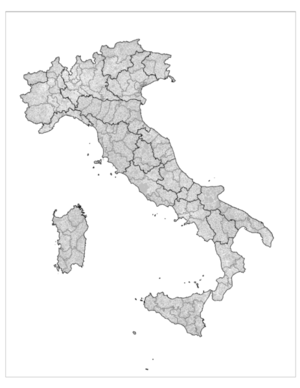Comuni
In Italy, the comune, (plural comuni) is the basic administrative division of both provinces and regions, and may be properly approximated in casual speech by the English word township or municipality.
Importance and function
The comune provides many of the basic civil functions: registry of births and deaths, registry of deeds, contracting for local roads and public works, etc.
It is headed by a mayor (sindaco) assisted by a council of aldermen, the Consiglio Comunale. The offices of the comune are housed in a building usually called the Municipio, or Palazzo Comunale.
As of the 2001 census, there were 8,101 comuni in Italy; they vary considerably in area and population.
For example, the comune of Rome (Lazio) has an area of 1,285.30 km² and a population of 2,546,804, and is both the largest and the most populated comune in Italy; Fiera di Primiero, in the province of Trento, is the smallest comune by area, with only 0.10 km², and Morterone (province of Lecco) is the smallest by population, with only 33 inhabitants.
The density of comuni varies widely by province and region: the province of Bari, for example, has 1,564,000 inhabitants in 48 municipalities, or over 32,000 inhabitants per municipality; whereas the Aosta Valley has 121,000 inhabitants in 74 municipalities, or 1,630 inhabitants per municipality – roughly twenty times more communal units per inhabitant. There are inefficiencies at both ends of the scale, and there is concern about optimizing the size of the comuni so they may best function in the modern world, but planners are hampered by the historical resonances of the comuni, which often reach back many hundreds of years, or even a full millennium: while provinces and regions are creations of the central government, and subject to fairly frequent border changes, the natural cultural unit is indeed the comune, – for many Italians, their hometown: in recent years especially, it has thus become quite rare for comuni either to merge or to break apart.
Many comuni also have a Polizia Municipale (municipal police) which is responsible for public order duties. Traffic control is their main function in addition to controlling commercial establishments to ensure they open and close according their license.
Subdivisions
A commune usually comprises:
- a principal town or village, that almost always gives its name to the comune; such a town is referred to as the capoluogo (“head place”, or “capital”) of the comune; the word comune is also used in casual speech to refer to the town hall.
- other outlying areas called frazioni (singular: frazione, abbreviated Fraz., literally “fraction”), each usually centred on a small town or village: for fuller details, see the article Frazione. These frazioni have usually never had any independent historical existence, but occasionally are former smaller comuni consolidated into a larger. They may also represent settlements which predated the capoluogo: the ancient town of Pollentia, for instance, today known as Pollenzo, is a frazione of Bra. In recent years the frazioni have become more important thanks to the instituction of the "Consiglio di Frazione", a local form of government which can can interact with the Comune and show it the local needs, requests and claims. Yet smaller places are called località (literally “localities” and often, as in the phonebook, abbreviated Loc.).
Some few frazioni are more populated than the capoluogo; and very occasionally, due to unusual circumstances or to the depopulation of the latter, the town hall and its administrative functions move to one of the frazioni: but the comune still retains the name of the capoluogo.
Eventually, some "comuni" have not a "capoluogo" but only some "frazioni": in these cases, the "frazione" which comprises the town hall is called "sede municipale" (town hall seat).
